This November, we’re taking a trip back in time to review the seventh season of The X-Files and the first (and only) season of Harsh Realm.
Religion is a major part of The X-Files. After all, what is the show but a meditation on faith?
In a way, this is an aspect that dates the series. While the show’s conspiracy theories and surveillance culture paranoia resonate as effectively in 2015 as they did in 1995, the show’s religious themes seem innocent and naive in the wake of 9/11 and the War on Terror. Signs and Wonders was broadcast towards the end of January 2000. It is hard to imagine the episode being produced even two years later, once the world had been so thoroughly shaken by acts of religious zealotry.
The X-Files exists as a product of the nineties, pre-dating what many have termed “the new atheism.” It exists against the backdrop of the Clinton era, in the space between the fall of the Berlin Wall and the start of the War on Terror. There are points when the shew resonates beyond that; The X-Files is often a profound and thoughtful meditation on issues like trust and faith. However, there are also points where The X-Files almost seems fused in time; where it seems like a moment has been captured in celluloid like a mosquito trapped in amber.
Signs and Wonders feels like one of those moments, sitting between the failed impeachment of President Bill Clinton and the triumphant election of President George W. Bush. This is what the last gasp of the nineties looks like.
The X-Files has tackled faith on a number of occasions. It has been a part of the show since the moment the camera caught sight of Mulder’s “I Want to Believe” poster in The Pilot. Mulder’s belief in extraterrestrials was explicitly suggested to be religious in nature by the final scene of Conduit, the show’s fourth episode. The series began meddling with explicitly religious themes late in that first season. Miracle Man featured an investigation of a child with miraculous powers, seemingly stalked by the devil.
The show has dabbled in religion on a couple of occasions. Revelations pushed Scully’s religious beliefs to the forefront, as she found herself tasked to protect a young stigmatic. All Souls featured Scully coping with the loss of her daughter while caught in the middle of a conflict between heaven and hell for the souls of four young girls. This is to say nothing of the religious themes that permeate the mythology, articulated by second season episodes like Red Museum or Fearful Symmetry but also playing through to Patient X and The Red and the Black or Biogenesis.
As The X-Files entered its seventh season, the religious themes became more pronounced. To be fair, this was foreshadowed somewhat by Chris Carter’s work on Millennium. His final script for that other television show, Seven and One, ended with the protagonist returning to church and embracing religious faith. In a way, it foreshadowed the religious themes that Carter would weave through the final scenes of The Truth as The X-Files came to an end three years later.
The union and the divine played out in the three-parter that bridged the sixth and seventh seasons. Mulder was transformed into a hybrid, essentially becoming half-alien. David Duchovny and Chris Carter’s script for The Sixth Extinction II: Amor Fati suggested that Mulder had also become divine; the structure of the episode mirrors that of The Passion of the Christ, with Mulder wearing a medical crown of thorns as he is crucified on an operating table. However, this was just the start.
The seventh season is populated with strong religious subtext. The Goldberg Variation suggested that perhaps the universe was one gigantic machine, a watch ticking to the beat of a celestial watchmaker. “Everything happens for a reason,” Richie Lupone suggests. “Only just sometimes it’s hard for us to see.” Scully offers a similar assessment at the end of the episode. Over the course of Orison, Scully questions whether there are more powerful religious forces at work in the world, and what they might possibly want.
In fact, the seventh season wraps up the show’s longest-running story arc in an explicitly religious manner. Sein Und Zeit and Closure suggest that the resolution to the mystery of Samantha Mulder has little to do with aliens or conspiracies; Mulder is able to find peace once he discovers that she has been taken to another place. Mulder does not interact with any aliens over the course of the two-parter, instead taking the opportunity to confront the literal ghost of his sister before she moves on.
Signs and Wonders handles its religious themes more overtly than any other seventh season episode, by virtue of taking place in a community caught between two competing religious institutions. The town of Blessing, Tennessee finds itself caught between the fundamentalist teachings of Reverend Enoch O’Connor and the more progressive religious philosophy of Reverend Samuel Mackey. After a series of snake-related deaths occur in the community, Mulder and Scully arrive to investigate what is really going on.
Jeffrey Bell’s script has a somewhat clever hook. Signs and Wonders is structured so that the audience originally believes that Reverend Enoch O’Connor is behind the weird snake-related attacks, perhaps as an attempt to scare the community to moral righteousness. After all, Reverend O’Connor is famed for his snake-handling, the religious process of handling poisonous snakes in the hope that righteousness will protect them from venom and death. Given Reverend O’Connor’s aggressive rhetoric, it certainly doesn’t seem out of character.
The episode’s big twist is that Reverend O’Connor is actually innocent. It turns out that the progressive and liberal Reverend Mackey is actually the villain of the piece. The episode is built around this twist, so the internal logic is kept intentionally fuzzy to preserve the surprise; Signs and Wonders often seems driven more by atmosphere than by logic. Nevertheless, the implication is that Reverend O’Connor is really a demonic snake creature who impregnated one of his flock, and is desperately covering up that moral lapse.
While the twist does mean that the character motivations are not always clear, it does pack a lot of punch. After all, Reverend O’Connor is preaching scripture that is downright hateful; it feels strange that he should be the heroic victim of the piece. “It’s not so hard to understand,” Mulder explains of Reverend O’Connor’s appeal. “It’s a culture with a very well-defined set of rules.” Scully retorts, “It’s an intolerant culture, Mulder.” Mulder counters, “Sometimes a little intolerance can be a welcome thing.”
The wishy-washy ambiguity and tolerance of Reverend Mackey lacks that energy and verve. One of the best sequences of the entire episode occurs early on, as the episode cuts between two similar sermons held by Reverend O’Connor and Reverend Mackey. “Tis better to be hot or cold than lukewarm,” Reverend O’Connor quotes from The Book of Revelation. While Reverend Mackey attempts to put the quote in its historical context (“John was specifically addressing the problems of the Church at Laodicea”), Reverend O’Connor is fire and brimstone.
Reverend Mackey might be technically correct, but his analysis is boring and staid. Reverend O’Connor bristles. There is practically an orgasmic energy as he baptises female members of the congregation. “God wants you hot!” he yells. “God wants you on fire!” Even watching the ceremony through television, the sequence is intoxicating. Kim Manners’ direction does a wonderful job capturing the charisma and lure of such aggressive and absolutist religious philosophy.
Jeffrey Bell’s script expands on the idea later on, in a way that is perhaps heavy-handed and unnecessary after that beautiful compare-and-contrast sequence. Mulder elaborates, “Clear-cut right and wrong, black and white, no shades of gray. You know, in a society where hard and fast rules are harder and harder to come by, I think some people would appreciate that.” He clarifies, “I’m just saying that somebody offering you all the answers could be a very powerful thing.” In a way, it makes sense that The X-Files would be drawn more to Reverend O’Connor.
After all, the show’s other religious episodes have suggested a similar idea; that it is better to believe absolutely and unquestioningly than it is to believe half-heartedly. In Revelations, Owen Jarvis questioned Scully’s religious devotion. In All Souls, the devil took the form of a secular social worker while a devout (and extremist) priest turned out to be an instrument of the Almighty. The X-Files has a very romantic view of fanaticism; there is a sense that show desperately wants to believe in an all-consuming way.
Mulder is driven by a faith every bit as extreme as that of Reverend O’Connor. Signs and Wonders suggests as much. While searching the Reverend O’Connor’s house, Mulder muses, “I don’t know, Scully. When you… when you get right down to it is snake handling any harder to buy into than communion wafers or transubstantiation…?” Scully retorts, “Or believing in flying saucers, for that matter.” According to The X-Files, absolute and unquestioning faith in the absurd is better than a life lived without such devotion.
In the world of The X-Files, compromise is the enemy. The moment that a person allows their firm convictions to be eroded by pragmatic concerns, they lose their way. The world of The X-Files is ultimately an absolutist one. There is good; there is evil. There is right; there is wrong. Faith is almost always rewarded, so long as it is held deeply and truly. Reverend Mackey is the enemy because he represents compromise and doubt that would undercut pure and unquestioning faith.
It is very strange to see a network drama romanticise unquestioning fanaticism in the context of the twenty-first century. Signs and Wonders belongs to a different point in history. It was broadcast between the failed impeachment of President Bill Clinton following his affair with intern Monica Lewinsky and the controversial election of President George W. Bush. Existing in that weird limbo between those two big political moments, Signs and Wonders feels like it could not have been produced at any other moment.
The United States is a very religious country. The politics of the country are tied into a web of religious concerns; up until 2011, more than half of the country would not vote for an openly atheist presidential candidate. The “religious right” has tremendous influence on the policies of the Republican Party. Fundamentalist Christian groups have been a major part of the Republican base dating back to President Eisenhower and President Nixon; however, it was Ronald Reagan who really began cultivating the religious right in earnest.
While Ronald Reagan seemed to be able to exert some control over the religious right, it seemed to quickly assert dominance over the Republican Party. As Neal Gabler observed, the religious right reacted to what it saw as the moral failing of contemporary culture:
Like the 18th-century colonies, 20th-century America seemed to be awash in sin. It wallowed in what Awakeners regarded as a vulgar popular culture, promiscuous sexual mores, recreational drugs and other forms of licentiousness. The Third Awakeners are determined to stop this descent not just through moral suasion, like their forebears, or even through social action but through government action. Indeed, the transformation of the Republican Party into a religious instrument is very likely the biggest political story of our time and one of the biggest cultural ones, too.
This cultural conflict simmered away during the Clinton Presidency, but was rapidly approaching boiling point as America entered the new millennium. The religious right seemed increasingly frustrated with how mainstream American culture had evolved, and how it responded to their moral concerns.
The debate about the role of religious values in everyday life became highly politicised. Socially conservative and highly active religious orders experienced the most significant growth of any religious orders during the nineties. Between 1992 and 2004, the proportion of evangelicals calling themselves Republicans rose from 48% to 56%. In 1999, the Inland Revenue Service officially removed the tax exemption from Church at Pierce Creek in Conklin; the religious organisation had been running political advertisements against Bill Clinton in the 1992 election.
Indeed, President Clinton seemed to provide a figure around which the “religious right” could rally. When President Clinton confessed to an extramarital affair with White House intern Monica Lewinsky in August 1998, the religious right could smell blood in the water. Largely motivated by the moral concerns of these religious crusaders, the Republican Party committed wholeheartedly to an investigation and condemnation of President Bill Clinton; the objective was nothing less than his impeachment and resignation.
Of course, the reality of the situation was that the religious right was not particularly concerned with this individual moral lapse. These groups hoped to dogpile on Clinton as part of a large condemnation of the man and the culture:
At the core of this large minority, there is that very substantial section of the American population whose conservatism is more religious than economic. It sees itself as being engaged in a holy war. It believes that the righteous have a right to rule. It sees Clinton as the embodiment of everything that is wrong with the 1960s generation – evasive, permissive, demand-fed and dirty, in favour of abortion and against guns. It is willing to sacrifice a great deal – popularity, national unity, the separation of powers, even the Republican Party itself – in order to advance its cause.
The amount of energy and money invested in trying to embarrass Bill Clinton as a public shaming of contemporary liberal America was mind-boggling. Nevertheless, this was the religious right’s stab at mainstream attention.
The kind of rhetoric employed during the scandal was certainly extremist. Addressing the Christian Coalition’s Road to Victory conference, noted evangelical (and failed presidential candidate) Pat Roberston laid into Clinton:
For nearly nine months, we have seen one man wreak havoc on our most noble office. For nine months, we have been mocked, demeaned, belittled and lied to. We have been forced, ourselves and our children, to endure an account so lurid that if it were made into a movie it would have been triple X-rated.
There was a sense of public spectacle to all of this, as if the religious right was glad to have the rapt attention of the wider population so that they might point out where the United States had gone so horribly wrong.
Of course, it didn’t actually work out like that. Bill Clinton was successfully impeached by the House of Representatives in December 1998, but the President was subsequently acquitted by the United States Senate in February 1999. Clinton did not resign; he served out his term successfully. The public rallied around Clinton in the wake of the scandal, siding with the target rather than the lynch mob. Indeed, Clinton’s legacy has been quite positive; Hillary Clinton served as Barrack Obama’s Secretary of State and seems a frontrunner for 2016.
This public failure was a major blow to the religious right. It was spectacle, a humiliation. It should have been a moment of triumph, but it ended in a significant defeat. It suggested that the mainstream was never going to entirely embrace their beliefs or their moral structures. Understandably, this only deepened the divide that had begun to form between certain fundamentalist strands of religious thought and the rest of American society. There was a fracture in place.
In response to the failure of the impeachment process, Paul M. Weyrich published a well-circulated “Letter to Conservatives” in February 1999. In that rallying cry, Weyrich suggested that the best strategy going forward was a disengagement from the mainstream:
I am very concerned, as I go around the country and speak and talk to young people, when I find how much of the decadent culture they have absorbed without even understanding that they are a part of it. And while I’m not suggesting that we all become Amish or move to Idaho, I do think that we have to look at what we can do to separate ourselves from this hostile culture. What steps can we take to make sure that we and our children are not infected? We need some sort of quarantine.
That is very much the language of war, with the enemy presented as mainstream American culture. Weyrich suggested, “We need to drop out of this culture, and find places, even if it is where we physically are right now, where we can live godly, righteous and sober lives.”
This is not a policy that fosters debate or inclusion; it is not an approach that builds bridges or encourages understanding. This rhetoric leads to fundamentalism and extremism. It is the doctrine the very much informs the character of Reverend O’Connor in Signs and Wonders, a character dripping with contempt for what he sees as a decadent country. “No one quite passes muster with you, huh?” Mulder mockingly asks; there is truth to be found in his sarcasm.
Reverend O’Connor is a man likely humiliated by the impeachment failure, who found his own little corner of the world where he could preach the gospel as he understood it while condemning the moral decay of outside culture. Signs and Wonders is quite clear that Reverend O’Connor is a deeply unpleasant man; he barred his daughter from his church (and his home) when she became pregnant out of wedlock. However, despite the fact that Reverend O’Connor is a hateful man, the show still finds some measure of sympathy or empathy for him.
In hindsight, the episode’s bizarre respect for Reverend O’Connor seems surreal. It is hard to feel too sympathetic to a character who would quite possibly advocate burning down abortion clinics or wave provocative placards at the funerals of servicemen returning from the Gulf. It is hard to feel too much empathy for a man not too far removed from the theocrats engaging in public stonings or advocating suicide bombings or staging recorded beheadings. In the twenty-first century, absolute and uncompromising faith is a deeply uncomfortable thing.
However, The X-Files is not a product of the twenty-first century. It exists as a relic of the listless nineties. It exists upon the nineties’ backdrop of existential angst and spiritual emptiness; factors that led to the growth of religion in the workplace during the decade. The number of Americans who agreed with the statement “I have old-fashioned values about family and marriage” peaked in 1999 and has declined since. The same is true of the statement “there are clear guidelines about what’s good or evil that apply to everyone.”
In the nineties, it seemed that people just wanted certainty; they wanted to know for certain that something was real and substantial. That is why Mulder so desperately wants tangible proof of his beliefs. Mulder spends the run of The X-Files trying to expose a conspiracy and to prove the existence of aliens; however, his quest never seems to be about exposing it to the public at large. Over the nine-year run of The X-Files, it seems like Mulder is driven to prove the existence and mechanics of the conspiracy to himself as much as (or more) than anybody else.
There was something romantic in a character like Reverend O’Connor, who could take something that seems ethereal or intangible to most viewers and render it concrete and absolute. At a time when it seemed like most Americans were wondering what the point of everything was, it felt like somebody like Reverend O’Connor had all the answers. The audience might not like the answers that he provided, but that had to be better than a shrug of the shoulders and a wishy-washy half-answer based on compromise and relativity.
There are some internal problems with the structure and logic of Jeffrey Bell’s script. Due to the nature of the central twist, a lot of Signs and Wonders can seem a bit fuzzy or irrational. If Reverend Mackey was killing people to cover us the fact that he impregnated Gracie, why not just kill Gracie and be done with it? That would seem to cover most of his tracks, without prompting too much attention. Similarly, did he kill Iris Finster to stop her from talking to Gracie or to the authorities? Or did he kill her simply to frame Reverend O’Connor?
These plotting issues aren’t a big problem, all said. Signs and Wonders is an episode that runs more on theme and atmosphere than on basic plotting. In the context of nineties television, The X-Files and Millennium had an interesting tendency to push plot into the background in service of core ideas or interesting concepts. There are certain episodes that might effectively be described as “mood television”, and Signs and Wonders is certainly an example of that storytelling style.
Given how reliant Signs and Wonders is on atmosphere and mood, the episode is very lucky to have Kim Manners directing. Manners is one of the show’s strongest directors; he is probably the strongest horror director still working on the show at this point. Manners understands tension and anxiety, and Signs and Wonders is dripping with both. The episode has a number of sequences where Mulder and Scully skulk around quiet and abandoned locations, all underscored with a palpable sense of dread.
Given the difficulty that The X-Files had with getting cats to act in Teso Dos Bichos, Manners manages to wrangle some brilliant performances from Signs and Wonders‘ reptilian guest stars. There are some striking and nightmarish compositions scattered throughout the episode; the snake birth scene is one of the most terrifying images the show has produced in quite a while. There is a tendency to dismiss The X-Files as a tired or exhausted quantity at this point in the run. The snake birth sequence would suggest the show can still be scary.
Signs and Wonders captures a weird moment in time. It demonstrates how fascinating The X-Files can be as a cultural artifact of the long nineties.
Filed under: The X-Files | Tagged: clinton, clinton impeachment, faith, impeachment, jeffrey bell, mulder, nineties, religion, religious right, scully, signs and wonders, the x-files, x-files |


















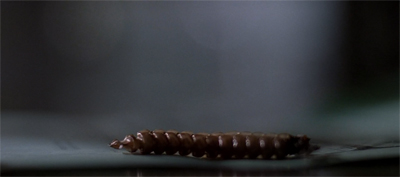




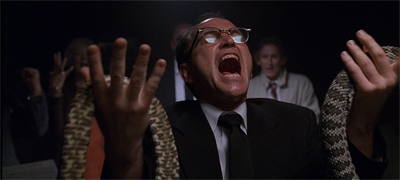


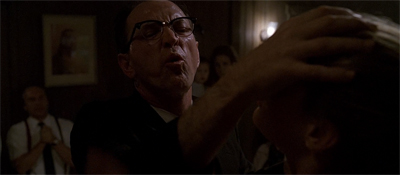
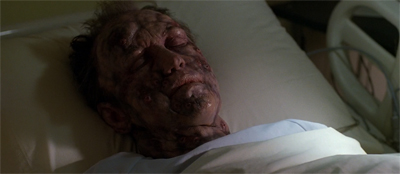






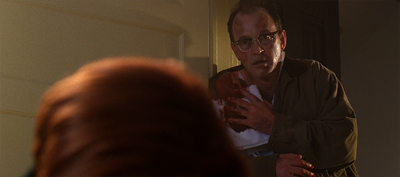







It’s been a while since I’ve seen this one but I see where it really holds up poorly. Perhaps, even much worse than Revelations and All Souls, which predated it. Maybe this is because it seems to let O’Connor off the hook.
But your comment about the snake birth reminded me of Roadrunners. That slug was nasty and I’d put that whole episode up against the snake birth scene to prove the show could still be scary. Regardless, thinking about Roadrunners does lead me back to my working theory that the “main” writers had a much different take on the religious themes. Before, I’ve used Morgan&Wong’s Die Hand and Field Where I Died as examples but Roadrunners fits as well in showing the dangers of these belief systems. Maybe Carter himself had more of a hand in the scripts by Newton, Angel and Bell.
Die Hand Die Verletzt was always an interesting case for me, if only because the episode seems to be suggest that the Satanists are being punished for adhering to a “Mass on Sunday” or “fair-weather faith” style of worship – the trappings of faith, but none of the commitment. (Of course, the episode is also fairly unambiguous that the treatment of their children is child abuse.) Although Vernon is portrayed as a monster in The Field Where I Died, the episode does firmly come down on the die of wanting to believe in something romantic even if it’s not verifiably true. (This is, after all, the episode that cause uproar in fandom for daring to suggest Mulder’s soulmate was a one-shot guest star.)
But I don’t think Morgan and Wong embrace it to the same extent as Carter and Spotnitz. These are the writers who turned the Millennium Group into a manipulative cult, much to the chagrin of other Millennium writers, after all. I think Frank Black’s (and Peter Watts’) arc with the Millennium Group in the second season of Millennium captures both the appeal of faith and the dangers of it more succinctly than any long-form X-Files character or plot arc. I suspect you’re right about it being a combination of those particular writers and the re-writes by Carter. Gilligan was well past being re-written at Carter by this point, I think. (There are definite shades of this absolutist faith in some of Carter’s credited work around this time – One and Seven and Closure in particular.)
Those are good points. I consider Die Hand one of Morgan & Wong’s weakest episodes. The humor just didn’t land right for me and, as you point out, the child abuse is all very uncomfortable. On the other hand, I am one of the few to really like The Field Where I Died. I’m not so sure it comes down on the romantic side. It does emphasize Mulder’s desire to want to believe in something romantic and somewhat absolutist. But while Revelations and All Souls end with Scully being a sort of religious hero and Signs and Wonders ends by letting an absolutist like O’Connor off the hook, The Field Where I Died ends with one of the grimmest tragedies of the entire run of The X-Files. To quote your review, “Mulder fails spectacularly.” It doesn’t implicate Mulder in the suicide so as to allow for the hopeful themes of the episode to shine through. But Morgan & Wong (and Darin) were never reluctant to criticize this aspect of Mulder’s character. Both X in One Breath and Scully in Quagmire warn him that his beliefs are getting everyone around him killed.
I am big fan of season 2 of Millennium.
That’s a fair point.
Funny you should mention not liking Die Hand. I always get a raised eyebrow when I describe it the show’s first comedy episode, largely because of the tonal shift from “PTA Satanists” to “Satanic Ritual Abuse.” Which is, admittedly, not a smooth tonal shift. (In a way, it predicts the shifts of Home, which starts with infant death and then moves to incest horror while being darkly cynically funny.)